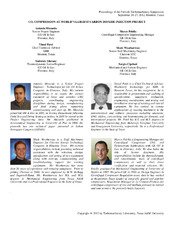| dc.description.abstract | Compressors for carbon dioxide (CO2) applications have been widely used in the O&G industry for urea production, enhanced oil recovery (EOR) and CO2 pipeline services for many years. New environmental challenges have re-focused the attention on increasing the efficiency of rotating equipment including optimization of the equipment configuration. To address these challenges, an electric motor driven CO2 compressor train has been designed for a large CO2 injection project in Western Australia. This compressor train was equipped with two compressor casings coupled through two gearboxes on either side of a double-ended variable frequency drive (VFD) motor. For the CO2 injection project, the risk of condensation inside the carbon steel pipeline between compressor discharge and the injection wells was identified as a concern. The mixture of liquid water and CO2 results in carbonic acid that may result in corrosion of the carbon steel pipeline. To mitigate this risk the water needs to be removed from the CO2 stream prior to entering the pipeline. To maximize the removal of water, the CO2 compressor intermediate stage (3rd stage) pressure is required to operate within a fixed pressure range. The compressor string with two gearboxes, two compressor casings and a VFD results in a complicated torsional system. In cases where torsional vibration frequencies coincide with resonance frequencies, large torsional deflections and internal stresses could be generated. Continuous operation under these conditions could result in fatigue failure. Free-vibration analysis and a forced-response analysis were conducted for an analytical review of rotor response to static and harmonic torsional loads. VFD motors generate pulsating torques; even if the pulsating torques are very small with respect to the main torque, they can excite compressor train resonances with potential shaft and/or couplings damages. Final validation of the compressor trains has been the Full Speed, Full Load test and ASME PTC10 Type 1 performance test campaign conducted in June 2011. During this testing, torque pulsation measurements has been conducted for validation of torsional analytical results and pulsation amplitudes under steady state and start-up conditions. The compressor train was designed to be modularized. This required the package’s overall dimensions to meet very stringent space constraints. The project engineering challenges include: ergonomic design focusing on improving maintenance and operations access, compressor supports stiffness analysis for installation on module steel work and compressor train operability assessment. High CO2 discharge pressures, high operating temperatures and the need to minimize fugitive emissions result in challenges for the dry gas seals system (DGS) and lead to the design of a highly customized DGS configuration. | en |


